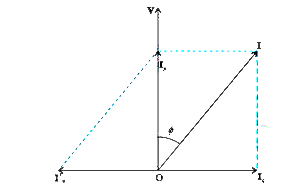(a) For circuits used for transporting electric power, a low power factor implies larger power loss in transmission. Explain.
(b) power factor can oftern be improved by the use of a capacitor of appropraite capacitance in the circuit, Explain.Solution in Tamil
(a) We know that P=IVcosϕ where cosϕ is the power factor. To supply a given power at a given voltage, if cosϕ is small, we have to increase current accordingly. But this will lead to large power loss (I2R) in transmission.
(b)Suppose in a circuit, current I lags the voltage by an angle ϕ. Then power factor cosϕ=R/Z.
We can improve the power factor (tending to 1) by making Z tend to R. Let us understand, with the help of a phasor diagram (Fig.) how this can be achieved. Let us resolve I into two components. Ip along

the applied voltage V and Iq perpendicular to the applied voltage. Iq as you have learnt in Section 7.7, is called the wattless component since corresponding to this component of current, there is no power loss. Ip is known as the power component because it is in phase with the voltage and corresponds to power loss in the circuit.
It’s clear from this analysis that if we want to improve power factor, we must completely neutralize the lagging wattless current Iq by an equal leading wattless current I.q. This can be done by connecting a capacitor of appropriate value in parallel so that Iq and I.q cancel each other and P is effectively IpV.
Topper's Solved these Questions
- ALTERNATING CURRENTBook:NCERT TAMILChapter:ALTERNATING CURRENTExercise:EXERCISES
Explore 11 Videos
- ALTERNATING CURRENTBook:NCERT TAMILChapter:ALTERNATING CURRENTExercise:ADDITIONAL EXERCISES
Explore 19 Videos
- ATOMIC AND NUCLEAR PHYSICSBook:NCERT TAMILChapter:ATOMIC AND NUCLEAR PHYSICSExercise:EVALUATION (Exercises)
Explore 13 Videos
Similar Questions
A 100Ω resistor is connected to a 220 V, 50 Hz ac supply.
(a) What is the rms value of current in the circuit?
(b) What is the net power consumed over a full cycle?
View SolutionAn LC circuit contains a 20 mH inductor and a 50μF capacitor with an initial charge of 10 mC. The resistance of the circuit is negligible. Let the instant the circuit is closed be t = 0.
(a) What is the total energy stored initially ? Is it conserved during the oscillalions?
(b) What is the natural frequency of the circuit?
(c ) At what time is the energy stored? (i) Completely electrical ? (ii) Completely magnetic ?
(d) At what time is the total energy shared equally between the inductor and the capacitor ?
(e) If a resistor is inserted in the circuit, how much energy is eventually dissipated as heat ?
View SolutionIn the Bohr atom model, the frequency of transitions is given by the following expression v=Rc(1n2−1m2), where n<m,
Consider the following transitions:

Show that the frequency of these transitions obey sum rule (which is known as Ritz combination principle)
View SolutionFor circuits used for transporting elecrtric power, a low power factor impleis larger power loss in transmission. Explain?
View Solution(a) For circuits used for transporting electric power, a low power factor implies larger power loss in transmission. Explain.
(b) power factor can oftern be improved by the use of a capacitor of appropraite capacitance in the circuit, Explain.
View Solutionविद्युत शक्ति की परिवहन के लिए प्रयुक्त होने वाले परिपथों में निम्न शक्ति गुणांक संप्रेषण में अधिक ऊर्जा का क्षय होने निर्दिष्ट करता है। कारण समझाइये ।
View Solutionविद्युत शक्ति के परिवहन के लिए प्रयुक्त परिपथ का शक्ति गुणांक प्रायः उस परिपथ में उपयुक्त मान के संधारित्र का उपयोग करके सुधारा जा सकता है। इस तथ्य को समझाइये।
View SolutionFor circuits used for transporting electric power, a low power factor implies large power loss in transmission. Explain.
View SolutionPower factor can often be improved by the use of a capacitor of appropriate capacitance in the circuit. Explain.
View Solution(a) For circuits used for transporting electric power, a low power factor implies large power loss in transmission. Explain.
(b) Power factor can often be improved by the use of a capacitor of appropriate capacitance in the circuit. Explain.
View Solutiona. For circuits used for transporting electric power, a low power factor implies large power loss in transmission. Explain.
b. Power factor can often be improved by the use of a capacitor of appropriate capacitance in the circuit. Explain.
View Solution(a) For circuits used for transporting electric power, a low power factor implies large power loss in transmission. Explain. (b) Power factor can often be improved by the use of a capacitor of appropriate capacitance in the circuit. Explain.
View Solution(a) For circuits used for transporting electric power, a low power factor implies large power loss in transmission. Explain.
(b) Power factor can often be improved by the use of a capacitor of appropriate capacitance in the circuit. Explain.
View Solution(a) For circuits used for transporting electric power, a low power factor implies large power loss in transmission. Explain.
(b) Power factor can often be improved by the use of a capacitor of appropriate capacitance in the circuit. Explain.
View Solution(a) For circuits used for transporting electric power, a low power factor implies larger power loss in transmission. Explain.
(b) power factor can oftern be improved by the use of a capacitor of appropraite capacitance in the circuit, Explain.
View SolutionFor circuits used for transporting electric power, a low power factor implies large power loss in transmission. Explain.
View Solution

